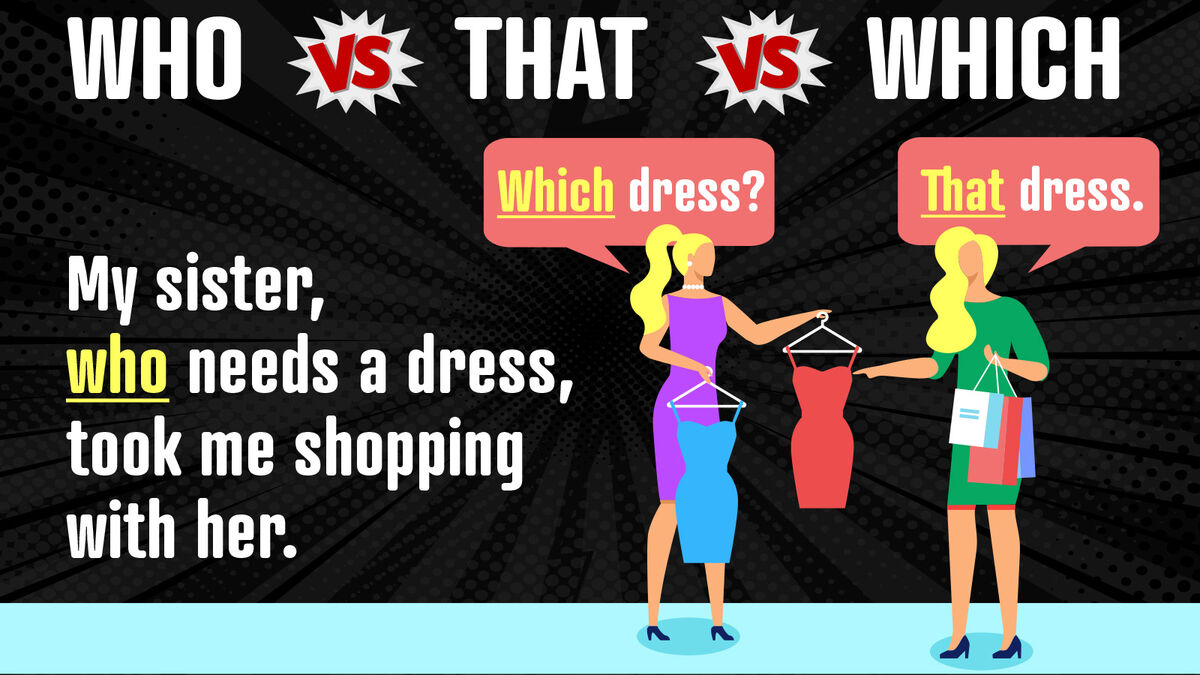
What’s the difference between which, that, and who? It seems like the answer should be straightforward, but it’s trickier than it seems. Keep reading to learn how to use these words correctly when describing another noun.
Who, That and Which Word Meanings
Even though these pronouns seem interchangeable, they’re not. There are specific times to use each one. Here are some quick ways to remember whether who, that, and which are the right words to use.
That overlaps meaning with who and which. So, why can’t you use that in every situation? It turns out that when you use these pronouns to introduce relative clauses, the sentence’s context determines which pronoun you should use.
Relative Pronouns
Who, that, and which are all relative pronouns. They connect a sentence’s noun or noun phrase to a modifying or explanatory clause. You can use a comma before who, that, and which when the clause is non-restrictive (non-essential to the sentence), or omit the comma for restrictive clauses (essential to understanding the sentence).
Who as a Relative Pronoun
Who is only appropriate when talking about people or plural groups of individual people, such as teachers, men, children, and actors. You can use who in either a non-restrictive or restrictive clause. Here are some examples of who as a relative pronoun.
- The store manager, who is friends with my dad, can get us a deal on a dining table.
- The runner who won the race is a cancer survivor.
- My sister, who lives three miles away, is coming over this afternoon.
- This is my friend Charlie, who I met back in college.
- The scientists who discovered the vaccine are attending the conference.
In each of these sentences, the relative clause after who clarifies more about the noun that precedes it. The sentences with non-restrictive clauses (with a comma) still make sense if you take the relative clause out, while the sentences with restrictive clauses (no comma) must keep who in place.
That as a Relative Pronoun
You can use that to describe objects, groups, or non-humans. That is a relative pronoun used in restrictive clauses without commas. For example:
- The contract that defines my work hours is on your desk.
- Janice called the bakery that makes John’s favorite cake.
- I want a car that accelerates quickly.
- You should take the job that pays the most.
- Let’s order the wine that Everly loves.
There is some debate as to whether a writer can use that instead of who in a sentence. Using that is acceptable in some informal cases, such as with animals or organizations that are composed of people (e.g., club, team, class), or when using that as a demonstrative pronoun. However, who is the preferred relative pronoun when talking about people.
Which as a Relative Pronoun
The difference between which and that is how they are used. They both identify objects and non-humans, but unlike that, which is appropriate in sentences with non-restrictive clauses. For example:
- The house next door, which used to belong to a local celebrity, is up for sale.
- Marina’s jacket, which she bought at a flea market, is too small.
- The purse in the window, which used to cost over $1,000, is now on sale.
- My wedding dress, which I bought last week, fits me perfectly.
- This computer, which used to work just fine, isn’t saving my files correctly.
All of these sentences are understandable if you remove the relative clauses that begin with which. When trying to decide if you should use that or which, look at the commas. If you use a comma to describe an object, use which. If you don’t use a comma, use that.
Interrogative Pronouns
Both who and which are also interrogative pronouns, which means that you can use them to ask questions. However, as you might have guessed, they are not interchangeable. Here are some ways to use who in interrogative sentences.
- Who ate the last piece of pizza?
- Who was the last student to arrive?
- I’ll ask Walker who else is coming.
- Who is receiving the award tonight?
- Who called the store this morning?
Each of these sentences, whether they are direct or indirect questions, has one goal: to find the identity of a person. But, when using which, the goal is deciding between two or more options. Unlike who, which is often accompanied by a noun. For example:
- Which dress looks best on me?
- Which appetizer would you prefer?
- Which plane should we take?
- See if Andy knows which address is right.
- Which movie would you like to see?
Both who and which are important pronouns to know when asking for more information. While that is not an interrogative pronoun, it can be used as a demonstrative pronoun to answer these questions. Check out these examples to see how:
- Who ate the last piece of pizza?
That guy ate the last piece of pizza. - Which dress looks best on me?
That red dress looks best on you.
Because you can’t use who or which to answer questions, that comes in handy. Using that to answer questions makes it clear which person or item you are talking about.
More Grammar Tips
If you’d like to learn more about pronouns, check out an article that provides lists and examples of personal, demonstrative, and indefinite pronouns. You can also learn more about subject vs. object pronouns and when to use each type.